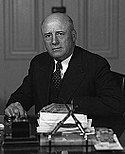267 seats 162 seats 222 209 45 47 Start date November 3, 1942 | 162 seats 3 seats 209 2 47 1 | |
 | ||
Winner Sam Rayburn | ||
The 1942 United States House of Representatives elections was held in the middle of President Franklin Delano Roosevelt's third term.
Contents
- Overall results
- Separate elections
- November elections
- Arizona
- California
- Florida
- Illinois
- Indiana
- Iowa
- Kansas
- Massachusetts
- Nebraska
- New Mexico
- North Carolina
- Ohio
- Oregon
- Pennsylvania
- Tennessee
- References
The main factor that led to the Republican gains during this election cycle was concern over World War II and American involvement.
Roosevelt's Democratic Party lost 45 seats, retaining only a slender majority even though they lost the popular vote by over 1 million votes (3.9%). This would not occur again until 1952, when the party who won the popular vote did not also win the majority of the House of Representatives.
Overall results
Source: Election Statistics - Office of the Clerk
Separate elections
Some special elections were held on dates other than in November.
November elections
Source: Election Statistics - Office of the Clerk
Arizona
Arizona received a second representative in reapportionment; it continued to elect both representatives at large rather than drawing districts.
California
Three new seats were added in reapportionment, increasing the delegation from 20 to 23 seats. Two of the new seats were won by Democrats, one by a Republican. One Republican and one Democratic incumbents lost re-election, and one vacancy was won by a Republican. Therefore, both Democrats and Republicans increased by 2 seats.
Florida
Florida received a 6th seat in reapportionment; it added an at-large district to its 5 districts rather than redrawing them.
Illinois
Illinois was reapportioned from 27 representatives to 26; it went from electing 2 at-large representatives to 1 without redrawing the other districts.
Indiana
Indiana was redrawn from 12 districts to 11 after reapportionment; most of the districts underwent minor boundary changes, and the old 11th district was divided up, distributing Madison County to the 5th, Hancock County to the 10th, and consolidating the parts of Marion County in the old 11th and Indianapolis-based 12th into a new 11th. This forced incumbents William H. Larrabee and Raymond S. Springer to run against each other in a district drawn mainly from Springer's old district.
Iowa
Iowa was redistricted from 9 to 8 districts, with the most substantial changes being merging the 2nd, 3rd, and 4th districts in northeastern Iowa down to 2 districts.
Kansas
Kansas was reapportioned from 7 districts to 6, with the central Kansas 4th district losing territory on its north and gaining most of the old 5th district around Wichita.
Massachusetts
Massachusetts was reapportioned from 15 districts down to 14, with the most affected incumbent being Thomas H. Eliot of the former 9th, whose western Boston suburbs were moved into the 10th and 4th while his Cambridge residence was pulled into the more urban 11th, where he was defeated in the primary by Jim Curley.
Nebraska
Redistricted from 5 districts down to 4; the 4th and 1st districts were merged into each other, with the other three districts all gaining some territory on the south.
New Mexico
Reapportioned from 1 representative to 2; both of the representatives were elected at large.
North Carolina
North Carolina was reapportioned from 11 seats to 12, and reorganized the existing 10th and 11th districts (in the western of the state) into three districts.
Ohio
Ohio was reapportioned from 24 seats to 23, and removed one of its two at-large seats while leaving the 22 geographical districts unchanged.
Oregon
Oregon redistricted from 3 districts to 4 by splitting the old 1st district (the western part of the state except Multnomah County) and putting the southern half (Linn and Lane counties and the counties to the south) into a 4th district.
Pennsylvania
Pennsylvania was reapportioned from 34 to 33 representatives, and redistricted from 34 to 32 geographical districts with one new at-large district. The Philadelphia-area districts were left pretty much unchanged, with the removal of one district in north-central Pennsylvania and another in Pittsburgh and compensating adjustments to nearby districts.
Tennessee
Tennessee was reapportioned from 9 districts to 10, and added an additional district in the central part of the state, allowing Davidson County to have its own district.
